Data and System Integration Report: Analysis and Recommendations
VerifiedAdded on 2023/06/03
|11
|3176
|438
Report
AI Summary
This report delves into the complexities of data and system integration, focusing on the challenges of consolidating data from disparate sources into a unified structure. It highlights the importance of enterprise architecture as an operating logic that defines how an organization manages its complexities of people, processes, and technology. The report examines intelligent enterprise design, exploring the concepts of current state and future state architecture, and emphasizes the significance of enterprise architecture principles. It also discusses various architecture domains and their sub-architectures, including business, data, applications, component, and technical architecture. Furthermore, the report covers enterprise information architecture reference architecture, detailing its benefits and different framework types. It concludes with a discussion on enterprise and architecture principles, along with common artifacts associated with enterprise architecture programs, such as requirements documents and UML models. The report provides valuable insights into the critical aspects of data and system integration, offering recommendations for enhanced data management and system interoperability.
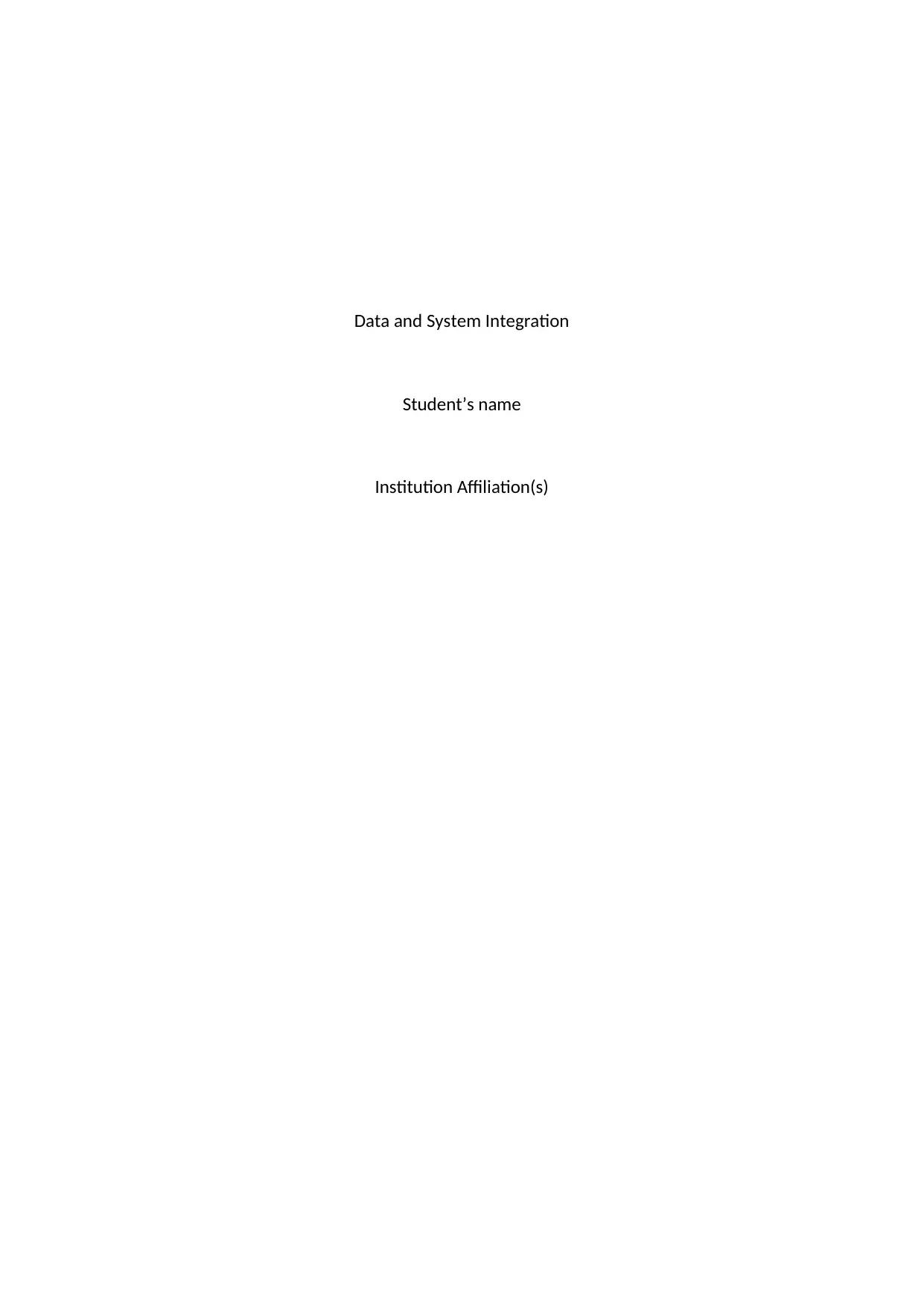
Data and System Integration
Student’s name
Institution Affiliation(s)
Student’s name
Institution Affiliation(s)
Paraphrase This Document
Need a fresh take? Get an instant paraphrase of this document with our AI Paraphraser
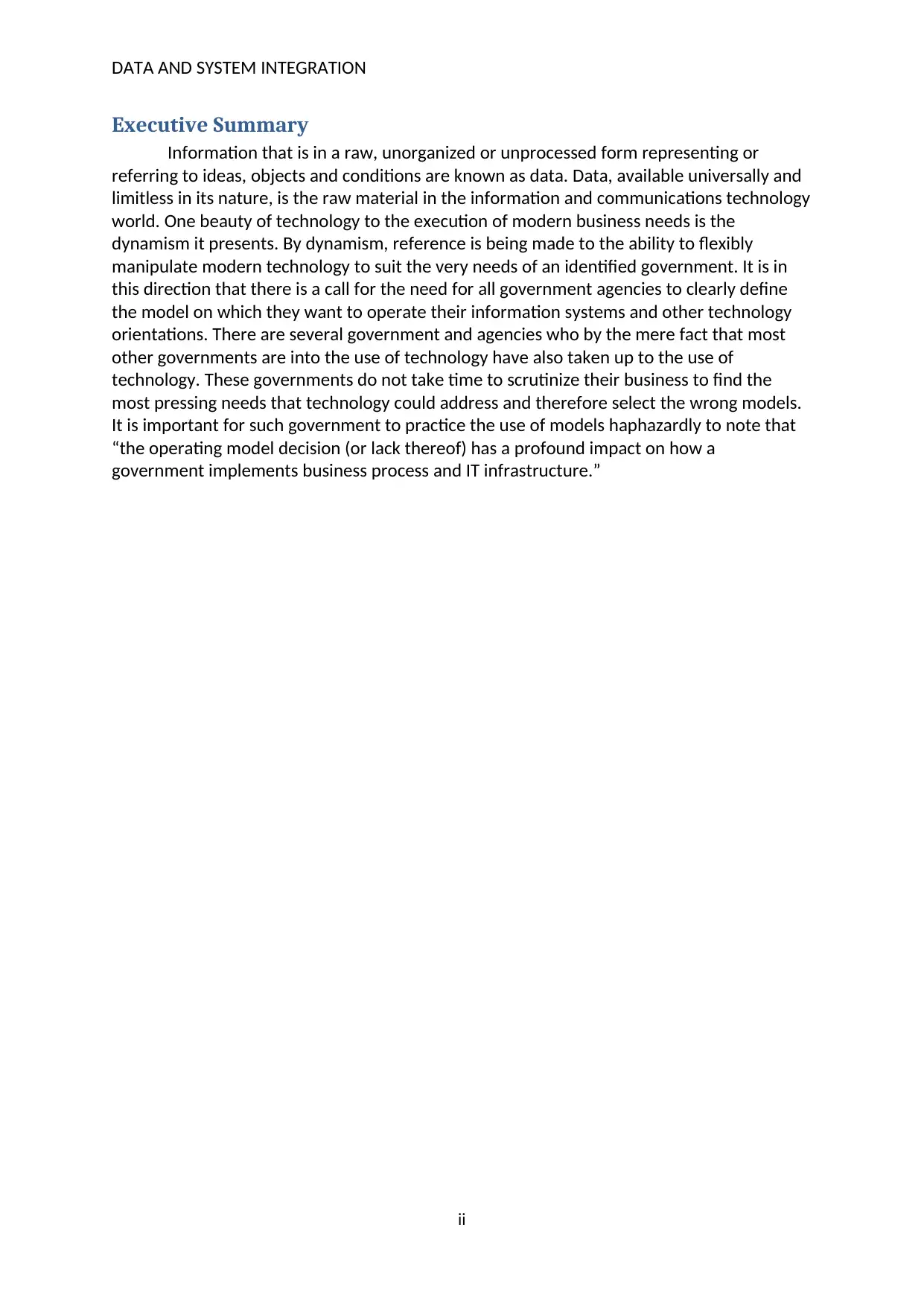
DATA AND SYSTEM INTEGRATION
Executive Summary
Information that is in a raw, unorganized or unprocessed form representing or
referring to ideas, objects and conditions are known as data. Data, available universally and
limitless in its nature, is the raw material in the information and communications technology
world. One beauty of technology to the execution of modern business needs is the
dynamism it presents. By dynamism, reference is being made to the ability to flexibly
manipulate modern technology to suit the very needs of an identified government. It is in
this direction that there is a call for the need for all government agencies to clearly define
the model on which they want to operate their information systems and other technology
orientations. There are several government and agencies who by the mere fact that most
other governments are into the use of technology have also taken up to the use of
technology. These governments do not take time to scrutinize their business to find the
most pressing needs that technology could address and therefore select the wrong models.
It is important for such government to practice the use of models haphazardly to note that
“the operating model decision (or lack thereof) has a profound impact on how a
government implements business process and IT infrastructure.”
ii
Executive Summary
Information that is in a raw, unorganized or unprocessed form representing or
referring to ideas, objects and conditions are known as data. Data, available universally and
limitless in its nature, is the raw material in the information and communications technology
world. One beauty of technology to the execution of modern business needs is the
dynamism it presents. By dynamism, reference is being made to the ability to flexibly
manipulate modern technology to suit the very needs of an identified government. It is in
this direction that there is a call for the need for all government agencies to clearly define
the model on which they want to operate their information systems and other technology
orientations. There are several government and agencies who by the mere fact that most
other governments are into the use of technology have also taken up to the use of
technology. These governments do not take time to scrutinize their business to find the
most pressing needs that technology could address and therefore select the wrong models.
It is important for such government to practice the use of models haphazardly to note that
“the operating model decision (or lack thereof) has a profound impact on how a
government implements business process and IT infrastructure.”
ii

Table of Contents
Executive Summary....................................................................................................................ii
Table of figures..........................................................................................................................iv
1.0 Introduction.........................................................................................................................1
2.0 Intelligent Enterprise Design................................................................................................1
2.1 Function 1.........................................................................................................................2
2.2 Function 2.........................................................................................................................2
3.0 Enterprise Information Architecture Reference Architecture.............................................2
4.0 Conclusion & Recommendations.........................................................................................5
References..................................................................................................................................7
iii
Executive Summary....................................................................................................................ii
Table of figures..........................................................................................................................iv
1.0 Introduction.........................................................................................................................1
2.0 Intelligent Enterprise Design................................................................................................1
2.1 Function 1.........................................................................................................................2
2.2 Function 2.........................................................................................................................2
3.0 Enterprise Information Architecture Reference Architecture.............................................2
4.0 Conclusion & Recommendations.........................................................................................5
References..................................................................................................................................7
iii
⊘ This is a preview!⊘
Do you want full access?
Subscribe today to unlock all pages.

Trusted by 1+ million students worldwide

DATA AND SYSTEM INTEGRATION
Table of figures
Figure 1: E-Government System................................................................................................3
Figure 2: Enterprise Architecture Information Flow..................................................................4
iv
Table of figures
Figure 1: E-Government System................................................................................................3
Figure 2: Enterprise Architecture Information Flow..................................................................4
iv
Paraphrase This Document
Need a fresh take? Get an instant paraphrase of this document with our AI Paraphraser
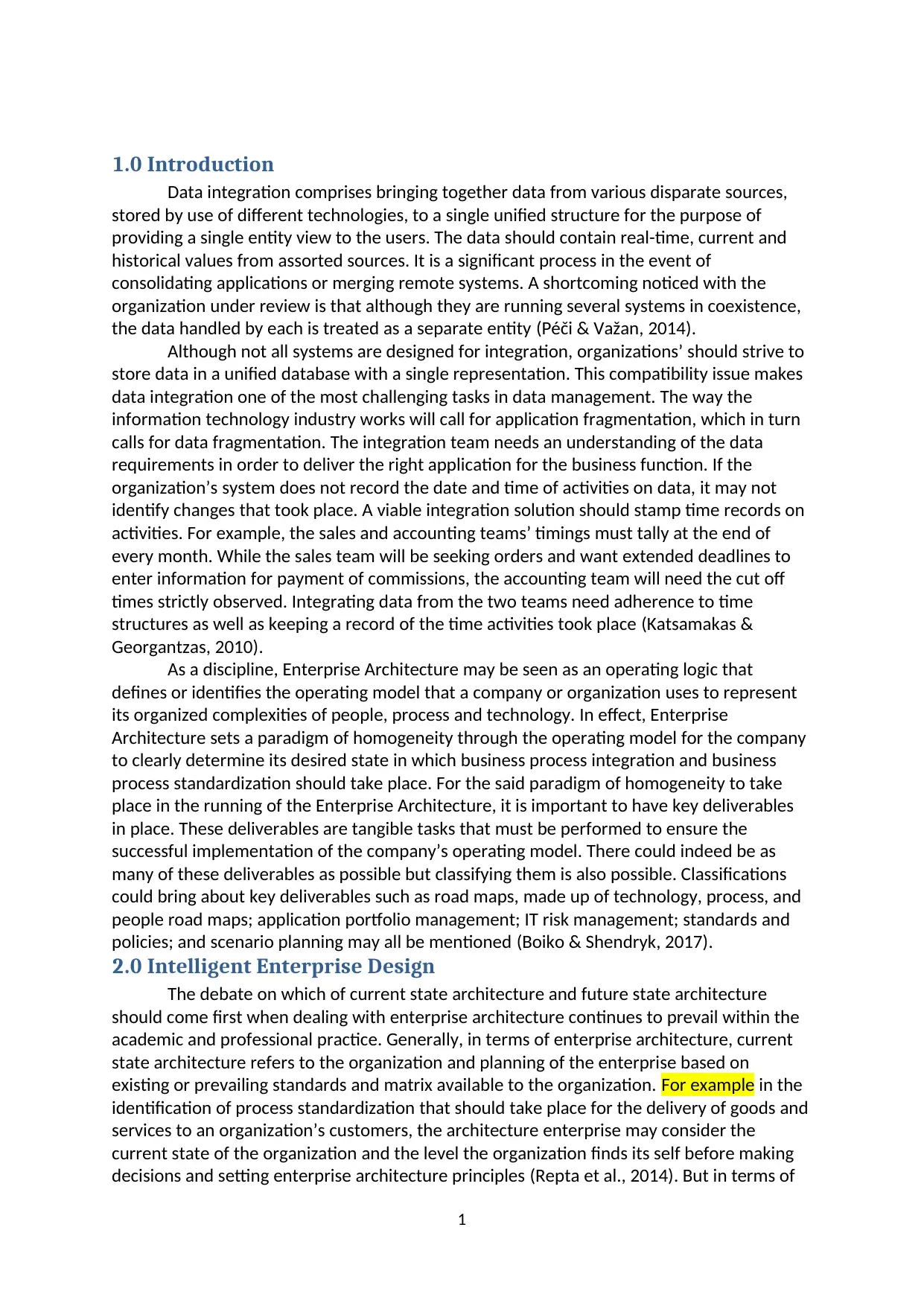
1.0 Introduction
Data integration comprises bringing together data from various disparate sources,
stored by use of different technologies, to a single unified structure for the purpose of
providing a single entity view to the users. The data should contain real-time, current and
historical values from assorted sources. It is a significant process in the event of
consolidating applications or merging remote systems. A shortcoming noticed with the
organization under review is that although they are running several systems in coexistence,
the data handled by each is treated as a separate entity (Péči & Važan, 2014).
Although not all systems are designed for integration, organizations’ should strive to
store data in a unified database with a single representation. This compatibility issue makes
data integration one of the most challenging tasks in data management. The way the
information technology industry works will call for application fragmentation, which in turn
calls for data fragmentation. The integration team needs an understanding of the data
requirements in order to deliver the right application for the business function. If the
organization’s system does not record the date and time of activities on data, it may not
identify changes that took place. A viable integration solution should stamp time records on
activities. For example, the sales and accounting teams’ timings must tally at the end of
every month. While the sales team will be seeking orders and want extended deadlines to
enter information for payment of commissions, the accounting team will need the cut off
times strictly observed. Integrating data from the two teams need adherence to time
structures as well as keeping a record of the time activities took place (Katsamakas &
Georgantzas, 2010).
As a discipline, Enterprise Architecture may be seen as an operating logic that
defines or identifies the operating model that a company or organization uses to represent
its organized complexities of people, process and technology. In effect, Enterprise
Architecture sets a paradigm of homogeneity through the operating model for the company
to clearly determine its desired state in which business process integration and business
process standardization should take place. For the said paradigm of homogeneity to take
place in the running of the Enterprise Architecture, it is important to have key deliverables
in place. These deliverables are tangible tasks that must be performed to ensure the
successful implementation of the company’s operating model. There could indeed be as
many of these deliverables as possible but classifying them is also possible. Classifications
could bring about key deliverables such as road maps, made up of technology, process, and
people road maps; application portfolio management; IT risk management; standards and
policies; and scenario planning may all be mentioned (Boiko & Shendryk, 2017).
2.0 Intelligent Enterprise Design
The debate on which of current state architecture and future state architecture
should come first when dealing with enterprise architecture continues to prevail within the
academic and professional practice. Generally, in terms of enterprise architecture, current
state architecture refers to the organization and planning of the enterprise based on
existing or prevailing standards and matrix available to the organization. For example in the
identification of process standardization that should take place for the delivery of goods and
services to an organization’s customers, the architecture enterprise may consider the
current state of the organization and the level the organization finds its self before making
decisions and setting enterprise architecture principles (Repta et al., 2014). But in terms of
1
Data integration comprises bringing together data from various disparate sources,
stored by use of different technologies, to a single unified structure for the purpose of
providing a single entity view to the users. The data should contain real-time, current and
historical values from assorted sources. It is a significant process in the event of
consolidating applications or merging remote systems. A shortcoming noticed with the
organization under review is that although they are running several systems in coexistence,
the data handled by each is treated as a separate entity (Péči & Važan, 2014).
Although not all systems are designed for integration, organizations’ should strive to
store data in a unified database with a single representation. This compatibility issue makes
data integration one of the most challenging tasks in data management. The way the
information technology industry works will call for application fragmentation, which in turn
calls for data fragmentation. The integration team needs an understanding of the data
requirements in order to deliver the right application for the business function. If the
organization’s system does not record the date and time of activities on data, it may not
identify changes that took place. A viable integration solution should stamp time records on
activities. For example, the sales and accounting teams’ timings must tally at the end of
every month. While the sales team will be seeking orders and want extended deadlines to
enter information for payment of commissions, the accounting team will need the cut off
times strictly observed. Integrating data from the two teams need adherence to time
structures as well as keeping a record of the time activities took place (Katsamakas &
Georgantzas, 2010).
As a discipline, Enterprise Architecture may be seen as an operating logic that
defines or identifies the operating model that a company or organization uses to represent
its organized complexities of people, process and technology. In effect, Enterprise
Architecture sets a paradigm of homogeneity through the operating model for the company
to clearly determine its desired state in which business process integration and business
process standardization should take place. For the said paradigm of homogeneity to take
place in the running of the Enterprise Architecture, it is important to have key deliverables
in place. These deliverables are tangible tasks that must be performed to ensure the
successful implementation of the company’s operating model. There could indeed be as
many of these deliverables as possible but classifying them is also possible. Classifications
could bring about key deliverables such as road maps, made up of technology, process, and
people road maps; application portfolio management; IT risk management; standards and
policies; and scenario planning may all be mentioned (Boiko & Shendryk, 2017).
2.0 Intelligent Enterprise Design
The debate on which of current state architecture and future state architecture
should come first when dealing with enterprise architecture continues to prevail within the
academic and professional practice. Generally, in terms of enterprise architecture, current
state architecture refers to the organization and planning of the enterprise based on
existing or prevailing standards and matrix available to the organization. For example in the
identification of process standardization that should take place for the delivery of goods and
services to an organization’s customers, the architecture enterprise may consider the
current state of the organization and the level the organization finds its self before making
decisions and setting enterprise architecture principles (Repta et al., 2014). But in terms of
1
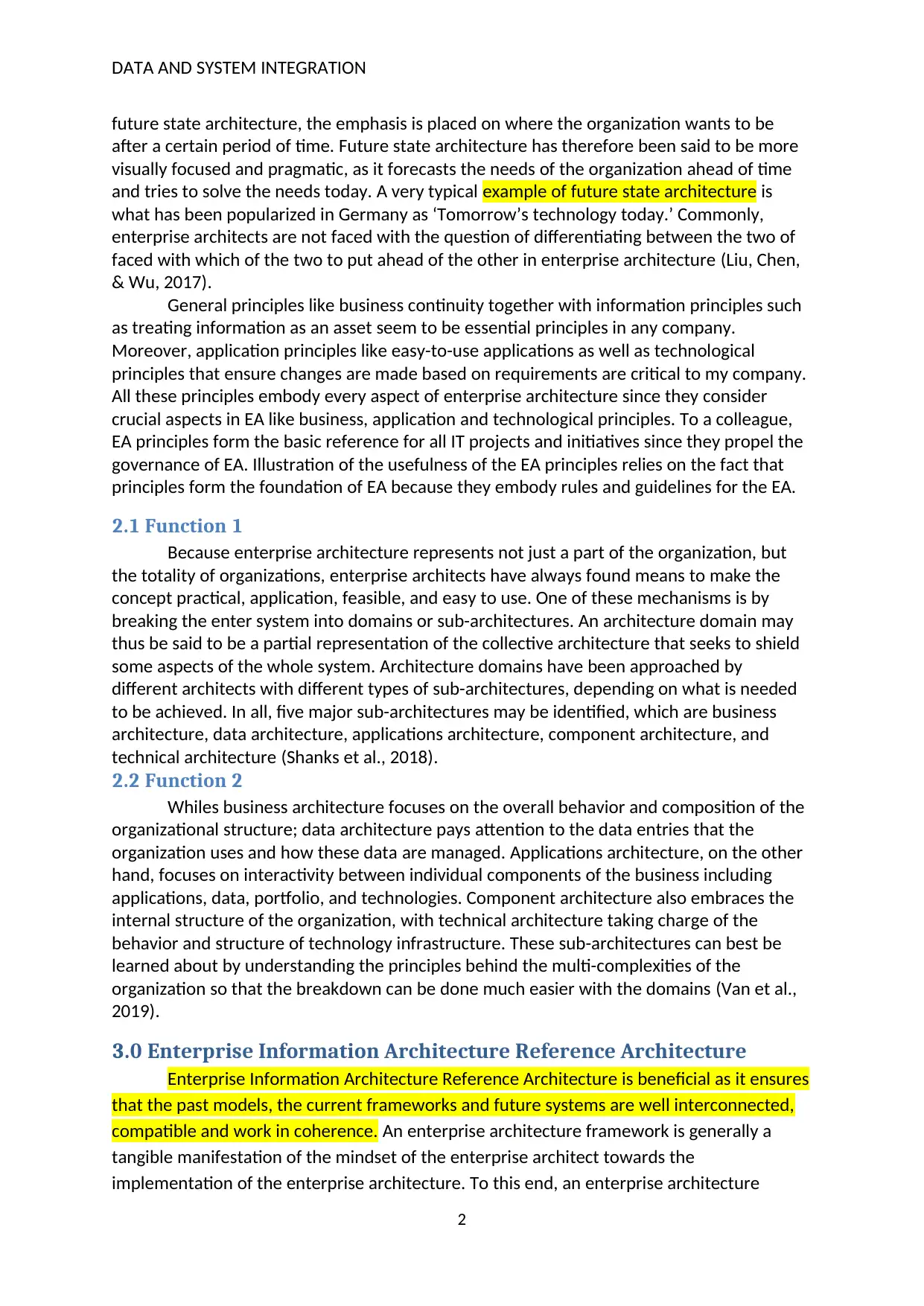
DATA AND SYSTEM INTEGRATION
future state architecture, the emphasis is placed on where the organization wants to be
after a certain period of time. Future state architecture has therefore been said to be more
visually focused and pragmatic, as it forecasts the needs of the organization ahead of time
and tries to solve the needs today. A very typical example of future state architecture is
what has been popularized in Germany as ‘Tomorrow’s technology today.’ Commonly,
enterprise architects are not faced with the question of differentiating between the two of
faced with which of the two to put ahead of the other in enterprise architecture (Liu, Chen,
& Wu, 2017).
General principles like business continuity together with information principles such
as treating information as an asset seem to be essential principles in any company.
Moreover, application principles like easy-to-use applications as well as technological
principles that ensure changes are made based on requirements are critical to my company.
All these principles embody every aspect of enterprise architecture since they consider
crucial aspects in EA like business, application and technological principles. To a colleague,
EA principles form the basic reference for all IT projects and initiatives since they propel the
governance of EA. Illustration of the usefulness of the EA principles relies on the fact that
principles form the foundation of EA because they embody rules and guidelines for the EA.
2.1 Function 1
Because enterprise architecture represents not just a part of the organization, but
the totality of organizations, enterprise architects have always found means to make the
concept practical, application, feasible, and easy to use. One of these mechanisms is by
breaking the enter system into domains or sub-architectures. An architecture domain may
thus be said to be a partial representation of the collective architecture that seeks to shield
some aspects of the whole system. Architecture domains have been approached by
different architects with different types of sub-architectures, depending on what is needed
to be achieved. In all, five major sub-architectures may be identified, which are business
architecture, data architecture, applications architecture, component architecture, and
technical architecture (Shanks et al., 2018).
2.2 Function 2
Whiles business architecture focuses on the overall behavior and composition of the
organizational structure; data architecture pays attention to the data entries that the
organization uses and how these data are managed. Applications architecture, on the other
hand, focuses on interactivity between individual components of the business including
applications, data, portfolio, and technologies. Component architecture also embraces the
internal structure of the organization, with technical architecture taking charge of the
behavior and structure of technology infrastructure. These sub-architectures can best be
learned about by understanding the principles behind the multi-complexities of the
organization so that the breakdown can be done much easier with the domains (Van et al.,
2019).
3.0 Enterprise Information Architecture Reference Architecture
Enterprise Information Architecture Reference Architecture is beneficial as it ensures
that the past models, the current frameworks and future systems are well interconnected,
compatible and work in coherence. An enterprise architecture framework is generally a
tangible manifestation of the mindset of the enterprise architect towards the
implementation of the enterprise architecture. To this end, an enterprise architecture
2
future state architecture, the emphasis is placed on where the organization wants to be
after a certain period of time. Future state architecture has therefore been said to be more
visually focused and pragmatic, as it forecasts the needs of the organization ahead of time
and tries to solve the needs today. A very typical example of future state architecture is
what has been popularized in Germany as ‘Tomorrow’s technology today.’ Commonly,
enterprise architects are not faced with the question of differentiating between the two of
faced with which of the two to put ahead of the other in enterprise architecture (Liu, Chen,
& Wu, 2017).
General principles like business continuity together with information principles such
as treating information as an asset seem to be essential principles in any company.
Moreover, application principles like easy-to-use applications as well as technological
principles that ensure changes are made based on requirements are critical to my company.
All these principles embody every aspect of enterprise architecture since they consider
crucial aspects in EA like business, application and technological principles. To a colleague,
EA principles form the basic reference for all IT projects and initiatives since they propel the
governance of EA. Illustration of the usefulness of the EA principles relies on the fact that
principles form the foundation of EA because they embody rules and guidelines for the EA.
2.1 Function 1
Because enterprise architecture represents not just a part of the organization, but
the totality of organizations, enterprise architects have always found means to make the
concept practical, application, feasible, and easy to use. One of these mechanisms is by
breaking the enter system into domains or sub-architectures. An architecture domain may
thus be said to be a partial representation of the collective architecture that seeks to shield
some aspects of the whole system. Architecture domains have been approached by
different architects with different types of sub-architectures, depending on what is needed
to be achieved. In all, five major sub-architectures may be identified, which are business
architecture, data architecture, applications architecture, component architecture, and
technical architecture (Shanks et al., 2018).
2.2 Function 2
Whiles business architecture focuses on the overall behavior and composition of the
organizational structure; data architecture pays attention to the data entries that the
organization uses and how these data are managed. Applications architecture, on the other
hand, focuses on interactivity between individual components of the business including
applications, data, portfolio, and technologies. Component architecture also embraces the
internal structure of the organization, with technical architecture taking charge of the
behavior and structure of technology infrastructure. These sub-architectures can best be
learned about by understanding the principles behind the multi-complexities of the
organization so that the breakdown can be done much easier with the domains (Van et al.,
2019).
3.0 Enterprise Information Architecture Reference Architecture
Enterprise Information Architecture Reference Architecture is beneficial as it ensures
that the past models, the current frameworks and future systems are well interconnected,
compatible and work in coherence. An enterprise architecture framework is generally a
tangible manifestation of the mindset of the enterprise architect towards the
implementation of the enterprise architecture. To this end, an enterprise architecture
2
⊘ This is a preview!⊘
Do you want full access?
Subscribe today to unlock all pages.

Trusted by 1+ million students worldwide
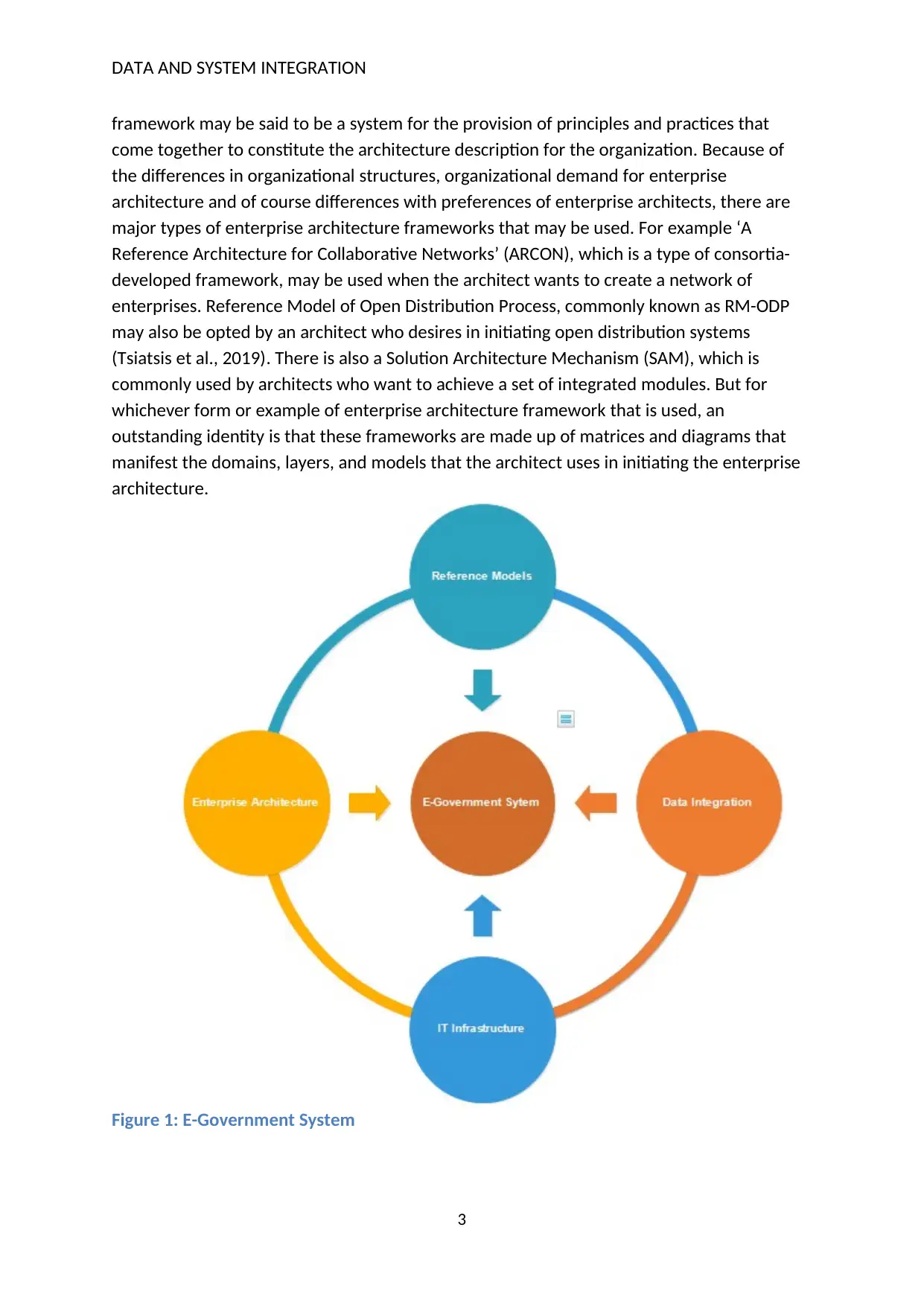
DATA AND SYSTEM INTEGRATION
framework may be said to be a system for the provision of principles and practices that
come together to constitute the architecture description for the organization. Because of
the differences in organizational structures, organizational demand for enterprise
architecture and of course differences with preferences of enterprise architects, there are
major types of enterprise architecture frameworks that may be used. For example ‘A
Reference Architecture for Collaborative Networks’ (ARCON), which is a type of consortia-
developed framework, may be used when the architect wants to create a network of
enterprises. Reference Model of Open Distribution Process, commonly known as RM-ODP
may also be opted by an architect who desires in initiating open distribution systems
(Tsiatsis et al., 2019). There is also a Solution Architecture Mechanism (SAM), which is
commonly used by architects who want to achieve a set of integrated modules. But for
whichever form or example of enterprise architecture framework that is used, an
outstanding identity is that these frameworks are made up of matrices and diagrams that
manifest the domains, layers, and models that the architect uses in initiating the enterprise
architecture.
Figure 1: E-Government System
3
framework may be said to be a system for the provision of principles and practices that
come together to constitute the architecture description for the organization. Because of
the differences in organizational structures, organizational demand for enterprise
architecture and of course differences with preferences of enterprise architects, there are
major types of enterprise architecture frameworks that may be used. For example ‘A
Reference Architecture for Collaborative Networks’ (ARCON), which is a type of consortia-
developed framework, may be used when the architect wants to create a network of
enterprises. Reference Model of Open Distribution Process, commonly known as RM-ODP
may also be opted by an architect who desires in initiating open distribution systems
(Tsiatsis et al., 2019). There is also a Solution Architecture Mechanism (SAM), which is
commonly used by architects who want to achieve a set of integrated modules. But for
whichever form or example of enterprise architecture framework that is used, an
outstanding identity is that these frameworks are made up of matrices and diagrams that
manifest the domains, layers, and models that the architect uses in initiating the enterprise
architecture.
Figure 1: E-Government System
3
Paraphrase This Document
Need a fresh take? Get an instant paraphrase of this document with our AI Paraphraser
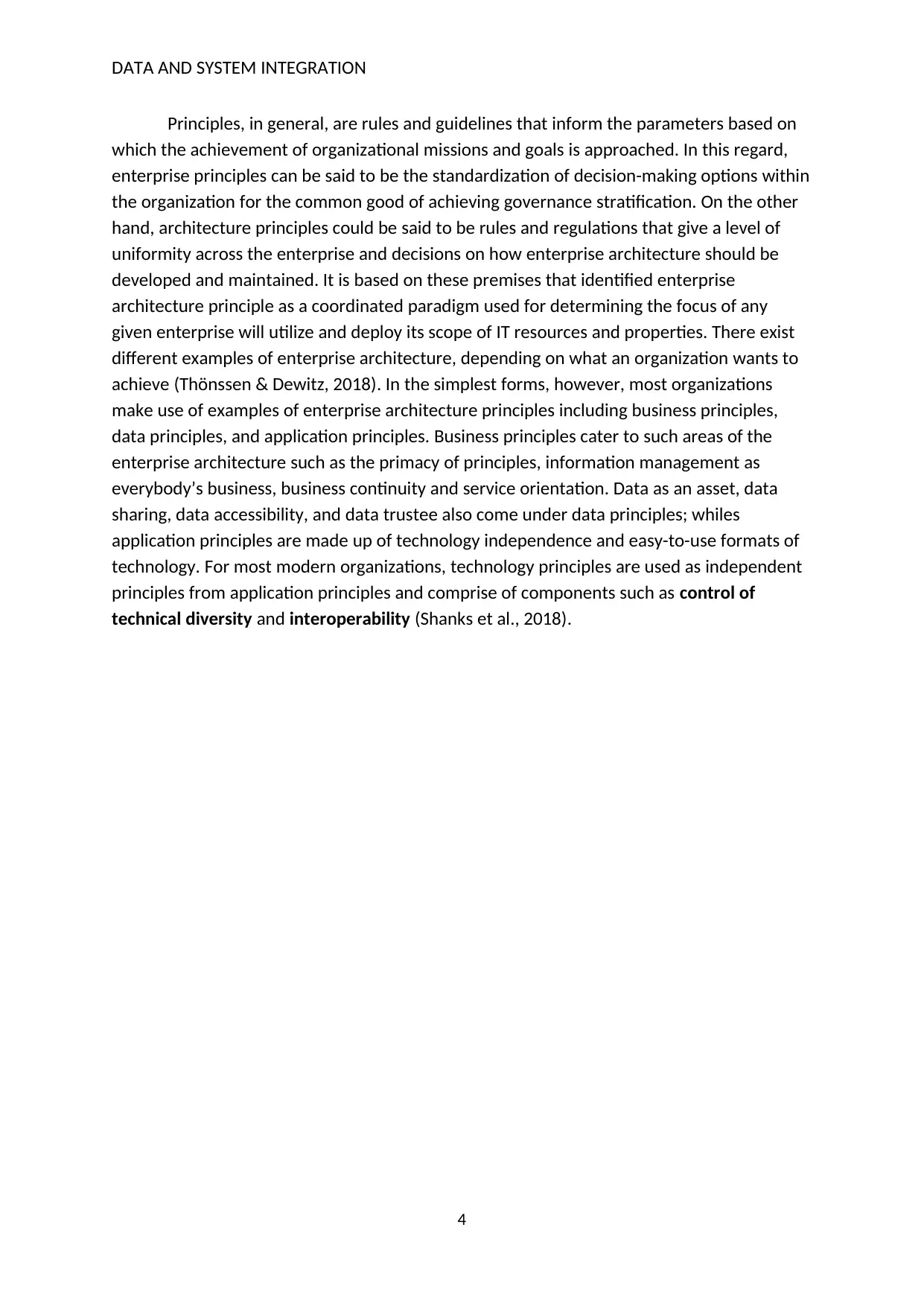
DATA AND SYSTEM INTEGRATION
Principles, in general, are rules and guidelines that inform the parameters based on
which the achievement of organizational missions and goals is approached. In this regard,
enterprise principles can be said to be the standardization of decision-making options within
the organization for the common good of achieving governance stratification. On the other
hand, architecture principles could be said to be rules and regulations that give a level of
uniformity across the enterprise and decisions on how enterprise architecture should be
developed and maintained. It is based on these premises that identified enterprise
architecture principle as a coordinated paradigm used for determining the focus of any
given enterprise will utilize and deploy its scope of IT resources and properties. There exist
different examples of enterprise architecture, depending on what an organization wants to
achieve (Thönssen & Dewitz, 2018). In the simplest forms, however, most organizations
make use of examples of enterprise architecture principles including business principles,
data principles, and application principles. Business principles cater to such areas of the
enterprise architecture such as the primacy of principles, information management as
everybody’s business, business continuity and service orientation. Data as an asset, data
sharing, data accessibility, and data trustee also come under data principles; whiles
application principles are made up of technology independence and easy-to-use formats of
technology. For most modern organizations, technology principles are used as independent
principles from application principles and comprise of components such as control of
technical diversity and interoperability (Shanks et al., 2018).
4
Principles, in general, are rules and guidelines that inform the parameters based on
which the achievement of organizational missions and goals is approached. In this regard,
enterprise principles can be said to be the standardization of decision-making options within
the organization for the common good of achieving governance stratification. On the other
hand, architecture principles could be said to be rules and regulations that give a level of
uniformity across the enterprise and decisions on how enterprise architecture should be
developed and maintained. It is based on these premises that identified enterprise
architecture principle as a coordinated paradigm used for determining the focus of any
given enterprise will utilize and deploy its scope of IT resources and properties. There exist
different examples of enterprise architecture, depending on what an organization wants to
achieve (Thönssen & Dewitz, 2018). In the simplest forms, however, most organizations
make use of examples of enterprise architecture principles including business principles,
data principles, and application principles. Business principles cater to such areas of the
enterprise architecture such as the primacy of principles, information management as
everybody’s business, business continuity and service orientation. Data as an asset, data
sharing, data accessibility, and data trustee also come under data principles; whiles
application principles are made up of technology independence and easy-to-use formats of
technology. For most modern organizations, technology principles are used as independent
principles from application principles and comprise of components such as control of
technical diversity and interoperability (Shanks et al., 2018).
4

DATA AND SYSTEM INTEGRATION
Figure 2: Enterprise Architecture Information Flow
Under each of the domains described earlier, there are specific artifacts or
deliverables that are common with them. Generally, artifacts, as used in this context, refers
to the list, tables, diagrams, and figures that the enterprise architect designs in the
delivering of the collective duty of enterprise architecture. The commonest forms of
artifacts that may be created from an enterprise architecture program include requirements
and design documents, use cases, class diagrams, and Unified Modeling Language, models.
A requirement and design document is a written description of the entire design and may be
used to serve the purpose of giving descriptive meanings to feature specifications found on
the architecture diagram (Lapalme et al., 2016). Unified modeling language models are also
graphic notations given to the static view and dynamic view of the enterprise architecture.
The purpose of unified modeling language models is thus to distinguish structural
components of the system from its behavioral systems. As the name implies, use cases list
cases or interactions that exist between actors and the system that is being created. It is
therefore useful in defining the roles of all actors within the enterprise architecture. Finally,
class diagrams break the larger domain down into classes, making it easier to comprehend
the process, even from a layman’s view.
5
Figure 2: Enterprise Architecture Information Flow
Under each of the domains described earlier, there are specific artifacts or
deliverables that are common with them. Generally, artifacts, as used in this context, refers
to the list, tables, diagrams, and figures that the enterprise architect designs in the
delivering of the collective duty of enterprise architecture. The commonest forms of
artifacts that may be created from an enterprise architecture program include requirements
and design documents, use cases, class diagrams, and Unified Modeling Language, models.
A requirement and design document is a written description of the entire design and may be
used to serve the purpose of giving descriptive meanings to feature specifications found on
the architecture diagram (Lapalme et al., 2016). Unified modeling language models are also
graphic notations given to the static view and dynamic view of the enterprise architecture.
The purpose of unified modeling language models is thus to distinguish structural
components of the system from its behavioral systems. As the name implies, use cases list
cases or interactions that exist between actors and the system that is being created. It is
therefore useful in defining the roles of all actors within the enterprise architecture. Finally,
class diagrams break the larger domain down into classes, making it easier to comprehend
the process, even from a layman’s view.
5
⊘ This is a preview!⊘
Do you want full access?
Subscribe today to unlock all pages.

Trusted by 1+ million students worldwide

DATA AND SYSTEM INTEGRATION
4.0 Conclusion & Recommendations
Governance remains important in enterprise architecture because governance is the
platform through which processes and tasks that are expected to be conducted can be
conducted properly and according to a given standard. Governance encompasses several
aspects and areas of the enterprise architecture including all five key domains of
architecture that have been described earlier. These domains are business architecture,
data architecture, applications architecture, component architecture, and technical
architecture. But even within each of the domains, governance takes place at various stages
of development. Is this means that processes within the enterprise architecture are
governed? Such governance system is necessary to ensure that the processes are orderly
and consistent with the scope within which they were initially set. Clearly, an enterprise
architecture that does not adhere to strict processes cannot be structured to yield results.
Implementation or decision making is also governed. In other words, architecture principles
are governed to ensure that decisions that are made as a result of the enterprise
architecture are those that can best meet the interest of the organization. The components
of governance and their importance has thus been summarized in TOGAF 8.1.1 as being
“less about overt control and strict adherence to rules, and more about guidance and
effective and equitable usage of resources to ensure the sustainability of an organization's
strategic objectives.” (Tsiatsis et al., 2019)
Today, it is a very common phenomenon to differentiate between an efficient IT
organization and one that is not merely by using the presence or absence of enterprise
architecture. This is said as enterprise architecture has been identified to affect the entire
organizational structure and organizational climate of any IT organization. Ideally, therefore,
the value of enterprise architecture is in providing governance over the entire IT
organization in such a manner that ensures the alignment of business needs with what IT
delivers. To the enterprise as a whole; therefore, enterprise architecture is necessary for the
provision of “clear singular vision for IT, and to work to ensure that vision is delivered. In the
long term, enterprise architecture affects organizations by ensuring that productivity and
general delivery takes place in a very rapid and IT cost-effective manner with guaranteed
success on IT programs and ease with the roles of human resource within the organization.
6
4.0 Conclusion & Recommendations
Governance remains important in enterprise architecture because governance is the
platform through which processes and tasks that are expected to be conducted can be
conducted properly and according to a given standard. Governance encompasses several
aspects and areas of the enterprise architecture including all five key domains of
architecture that have been described earlier. These domains are business architecture,
data architecture, applications architecture, component architecture, and technical
architecture. But even within each of the domains, governance takes place at various stages
of development. Is this means that processes within the enterprise architecture are
governed? Such governance system is necessary to ensure that the processes are orderly
and consistent with the scope within which they were initially set. Clearly, an enterprise
architecture that does not adhere to strict processes cannot be structured to yield results.
Implementation or decision making is also governed. In other words, architecture principles
are governed to ensure that decisions that are made as a result of the enterprise
architecture are those that can best meet the interest of the organization. The components
of governance and their importance has thus been summarized in TOGAF 8.1.1 as being
“less about overt control and strict adherence to rules, and more about guidance and
effective and equitable usage of resources to ensure the sustainability of an organization's
strategic objectives.” (Tsiatsis et al., 2019)
Today, it is a very common phenomenon to differentiate between an efficient IT
organization and one that is not merely by using the presence or absence of enterprise
architecture. This is said as enterprise architecture has been identified to affect the entire
organizational structure and organizational climate of any IT organization. Ideally, therefore,
the value of enterprise architecture is in providing governance over the entire IT
organization in such a manner that ensures the alignment of business needs with what IT
delivers. To the enterprise as a whole; therefore, enterprise architecture is necessary for the
provision of “clear singular vision for IT, and to work to ensure that vision is delivered. In the
long term, enterprise architecture affects organizations by ensuring that productivity and
general delivery takes place in a very rapid and IT cost-effective manner with guaranteed
success on IT programs and ease with the roles of human resource within the organization.
6
Paraphrase This Document
Need a fresh take? Get an instant paraphrase of this document with our AI Paraphraser

DATA AND SYSTEM INTEGRATION
References
Boiko, A., & Shendryk, V. (2017). System Integration and Security of Information Systems.
Procedia Computer Science, 104, 35–42. https://doi.org/10.1016/j.procs.2017.01.053
Katsamakas, E. G., & Georgantzas, N. C. (2010). Performance effects of information systems
integration:: A system dynamics study in a media firm. Business Process Management
Journal, 16(5), 822–846. https://doi.org/10.1108/14637151011076494
Lapalme, J., Gerber, A., Van der Merwe, A., Zachman, J., Vries, M. D., & Hinkelmann, K.
(2016). Exploring the future of enterprise architecture: A Zachman perspective. Computers
in Industry, 79, 103–113. https://doi.org/10.1016/j.compind.2015.06.010
Liu, F., Chen, C., & Wu, W. (2017). Research on Intelligent Design of Luxury Yacht. Procedia
Engineering, 174, 927–933. https://doi.org/10.1016/j.proeng.2017.01.243
Péči, M., & Važan, P. (2014). Choosing the Right Systems Integration. Research Papers
Faculty of Materials Science and Technology Slovak University of Technology, 22(35), 23–30.
https://doi.org/10.2478/rput-2014-0031
Repta, D., Sacala, I. S., Moisescu, M. A., & Stanescu, A. M. (2014). Towards the development
of a Cyber-Intelligent Enterprise System Architecture. IFAC Proceedings Volumes, 47(3),
827–832. https://doi.org/10.3182/20140824-6-ZA-1003.01681
Shanks, G., Gloet, M., Asadi Someh, I., Frampton, K., & Tamm, T. (2018). Achieving benefits
with enterprise architecture. The Journal of Strategic Information Systems, 27(2), 139–156.
https://doi.org/10.1016/j.jsis.2018.03.001
Thönssen, B., & Dewitz, M. (2018). A Label is not enough – Approach for an Enterprise
Architecture Role Description Framework. Procedia Computer Science, 138, 409–416.
https://doi.org/10.1016/j.procs.2018.10.058
Tsiatsis, V., Karnouskos, S., Höller, J., Boyle, D., & Mulligan, C. (2019). Chapter 8 -
Architecture Reference Model. In V. Tsiatsis, S. Karnouskos, J. Höller, D. Boyle, & C. Mulligan
(Eds.), Internet of Things (Second Edition) (pp. 181–234). https://doi.org/10.1016/B978-0-
12-814435-0.00020-1
Van Berg, M., Slot, R., van Steenbergen, M., Faasse, P., & van Vliet, H. (2019). How
enterprise architecture improves the quality of IT investment decisions. Journal of Systems
and Software, 152, 134–150. https://doi.org/10.1016/j.jss.2019.02.053
7
References
Boiko, A., & Shendryk, V. (2017). System Integration and Security of Information Systems.
Procedia Computer Science, 104, 35–42. https://doi.org/10.1016/j.procs.2017.01.053
Katsamakas, E. G., & Georgantzas, N. C. (2010). Performance effects of information systems
integration:: A system dynamics study in a media firm. Business Process Management
Journal, 16(5), 822–846. https://doi.org/10.1108/14637151011076494
Lapalme, J., Gerber, A., Van der Merwe, A., Zachman, J., Vries, M. D., & Hinkelmann, K.
(2016). Exploring the future of enterprise architecture: A Zachman perspective. Computers
in Industry, 79, 103–113. https://doi.org/10.1016/j.compind.2015.06.010
Liu, F., Chen, C., & Wu, W. (2017). Research on Intelligent Design of Luxury Yacht. Procedia
Engineering, 174, 927–933. https://doi.org/10.1016/j.proeng.2017.01.243
Péči, M., & Važan, P. (2014). Choosing the Right Systems Integration. Research Papers
Faculty of Materials Science and Technology Slovak University of Technology, 22(35), 23–30.
https://doi.org/10.2478/rput-2014-0031
Repta, D., Sacala, I. S., Moisescu, M. A., & Stanescu, A. M. (2014). Towards the development
of a Cyber-Intelligent Enterprise System Architecture. IFAC Proceedings Volumes, 47(3),
827–832. https://doi.org/10.3182/20140824-6-ZA-1003.01681
Shanks, G., Gloet, M., Asadi Someh, I., Frampton, K., & Tamm, T. (2018). Achieving benefits
with enterprise architecture. The Journal of Strategic Information Systems, 27(2), 139–156.
https://doi.org/10.1016/j.jsis.2018.03.001
Thönssen, B., & Dewitz, M. (2018). A Label is not enough – Approach for an Enterprise
Architecture Role Description Framework. Procedia Computer Science, 138, 409–416.
https://doi.org/10.1016/j.procs.2018.10.058
Tsiatsis, V., Karnouskos, S., Höller, J., Boyle, D., & Mulligan, C. (2019). Chapter 8 -
Architecture Reference Model. In V. Tsiatsis, S. Karnouskos, J. Höller, D. Boyle, & C. Mulligan
(Eds.), Internet of Things (Second Edition) (pp. 181–234). https://doi.org/10.1016/B978-0-
12-814435-0.00020-1
Van Berg, M., Slot, R., van Steenbergen, M., Faasse, P., & van Vliet, H. (2019). How
enterprise architecture improves the quality of IT investment decisions. Journal of Systems
and Software, 152, 134–150. https://doi.org/10.1016/j.jss.2019.02.053
7
1 out of 11